PLANS have been unveiled for a new, lighter train that could reduce operating costs and potentially save 9000km of marginal lines in rural France from closure.
The Innovative Light Train (TLI) project is being managed by French National Railways (SNCF) with 10 partners including CAF and Wabtec. This train is now being touted as the replacement for the single-car SNCF X 73500 DMU, of which 337 were built between 1999 and 2004 by Alstom DDF and LHB.
Weighing 48 tonnes with four axles and seating 80 passengers, the 29m-long X 73500 was originally seen as a light train designed to save France’s rural lines.
The TLI project aims to reduce costs by 30% and could potentially increase service frequency as the train is designed for driverless operation. However, the vehicles will begin operating with a driver and the regional councils that fund and specify local rail services are unlikely to sanction the removal of the second onboard staff member. The new trains will be able to operate in multiples of up to three.
The TLI will consist of two cars resting on three wheelsets of six stub axles, which are being developed by Limoges-based firm Texelis. These will reduce weight and make maintenance easier. They will be fitted with a device to ensure that the wheels activate track circuits, solving a major issue with the X 73500 which does not have tread brakes and was regularly lost on signalling systems. This was fixed by a retrofit of simple wheel surface scrapers.
The driver will be located in a central rooftop position although the forward view will be provided on a video screen. Remote control of the train would be an option and the views being filmed could be useful for infrastructure monitoring.
The 25-30m-long TLI will be manufactured with light materials including aluminium and composites. Interiors will be modular, allowing adaptation to carry bulky luggage such as skis or surf boards, or even for carrying small freight consignments.
Traction power will be provided by batteries with a range of up to 300km, with rapid recharging possible at the end of each journey. Infrastructure manager SNCF Network is also exploring the use of low-cost electrification involving electrification islands on the minor routes. Hydrogen power is an option where trains operate over longer distances.
Whereas other French light train projects depend on the separation of minor lines from the main line network to avoid adding train weight by reinforcing the body against major impact, the TLI will be designed to be fully TSI compliant to allow operation on main lines to reach major stations. The TLI will be equipped with both ETCS and the current KVB signalling equipment.
A prototype TLI is not expected before 2026 and, if it is successful, entry into service would be in around 2029.
Taxirail
Meanwhile, Taxirail, one of the most advanced light train projects, is set to begin tests of its concept on a 1.6km section of disused track at an industrial estate in Gravenchon-Port Jérôme by the end of this year.
Taxirail’s concept is a six-tonne, two-axle 20-seat driverless vehicles, which would run on demand, with passengers using a mobile application to select the time of operation. It is planning to extend testing to the current freight-only Bréauté-Beuzeville - Gravenchon-Port Jérôme line.





